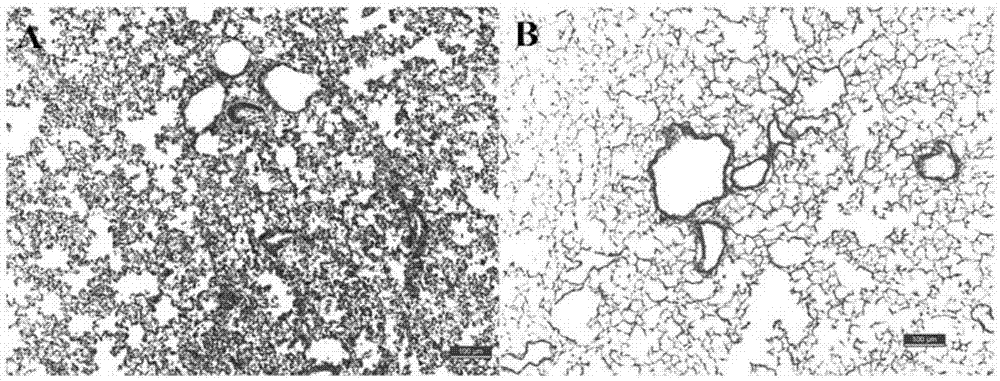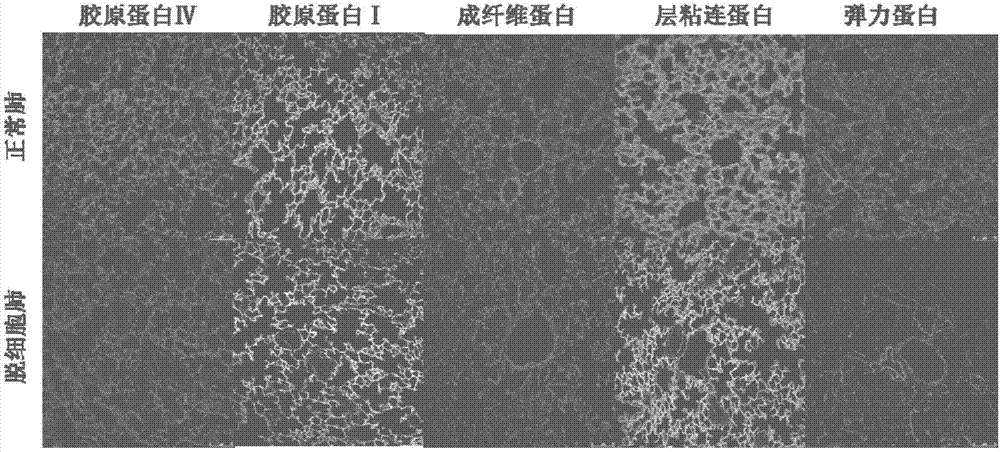Decellularized pulmonary support and preparation method thereof
A technology of decellularization and dodecyl ether, applied in the field of decellularized lung scaffolds and its preparation, can solve the problems of severe respiratory membrane rupture, restriction of lung transplantation, immune rejection, etc., and achieve good cellularization and vascularization, Conducive to quantitative production and unified preparation methods
- Summary
- Abstract
- Description
- Claims
- Application Information
AI Technical Summary
Problems solved by technology
Method used
Image
Examples
Embodiment 1
[0055] 1. Rat lung extraction
[0056] Select healthy male clean-grade SD rats, weighing 250-350g, aged 8-12 weeks, fasting for 12 hours and drinking water for 4 hours before the operation. Intraperitoneal injection of heparin, 1000U / Kg, 15min later intraperitoneal injection of 3% pentobarbital solution, the dosage is 150mg / Kg for anesthesia. After successful anesthesia, the rats were placed in a supine position, and the limbs were fixed on the operating table with thumbtacks. Thoracic and abdominal surgical areas were prepared for skin preparation and routinely disinfected. A combined midline incision was made in the chest and abdomen, about 5-8 cm in length. The diaphragm and ribs were cut open, and the thymus was removed to expose the heart and lungs. The abdominal viscera were removed with a cotton swab, and the abdominal aorta and main vein were cut off to let blood out. Inject 20-50ml of normal saline through the right ventricle. Each 1ml of normal saline contains 50U ...
experiment example 1
[0068] Different perfusion methods were used to observe the lung status of rats, such as figure 1 As shown, A is a normal rat lung taken out of the refrigerator, separated from the heart, inserted into a 16G perfusion head through the main pulmonary artery, and suspended to the Langendorff operating table to wait for perfusion. B is perfusion with 0.1% SLES solution at a flow rate of 5ml / min. After 2 hours, the lungs are basically transparent. In order to achieve the effect of basic transparency, the perfusion time can be extended to 3 hours. C is 1 hour after infusion of DNase I solution with a concentration of 30ug / ml, the flow rate is 2ml / min, which makes the lungs more crystal clear. D is the decellularized lung scaffold prepared by the present invention after the perfusion is finally completed. After perfusing the methylene blue dye solution into the stent prepared by the method of the E researcher, it can be seen that the blue dye solution is evenly distributed and the ...
experiment example 2
[0070] figure 2 It is the comparison chart of HE staining between normal rat lung tissue and the lung scaffold prepared by the present invention; normal lung lobes and decellularized lung scaffold lung lobes were randomly selected according to the conventional HE staining steps, that is, routine HE staining after fixation, dehydration, embedding, and preparation of slices. Such as figure 2 As shown, A is the HE staining of normal rat lung tissue, and the tissue is full of cells; B is the HE staining of the lung scaffold prepared by the present invention, the tissue has no obvious cell distribution, magnified 100 times, and the scale bar is 100um. pass figure 2 It can be concluded that the method of the present invention can completely remove normal lung cells.
PUM
 Login to View More
Login to View More Abstract
Description
Claims
Application Information
 Login to View More
Login to View More - R&D
- Intellectual Property
- Life Sciences
- Materials
- Tech Scout
- Unparalleled Data Quality
- Higher Quality Content
- 60% Fewer Hallucinations
Browse by: Latest US Patents, China's latest patents, Technical Efficacy Thesaurus, Application Domain, Technology Topic, Popular Technical Reports.
© 2025 PatSnap. All rights reserved.Legal|Privacy policy|Modern Slavery Act Transparency Statement|Sitemap|About US| Contact US: help@patsnap.com



